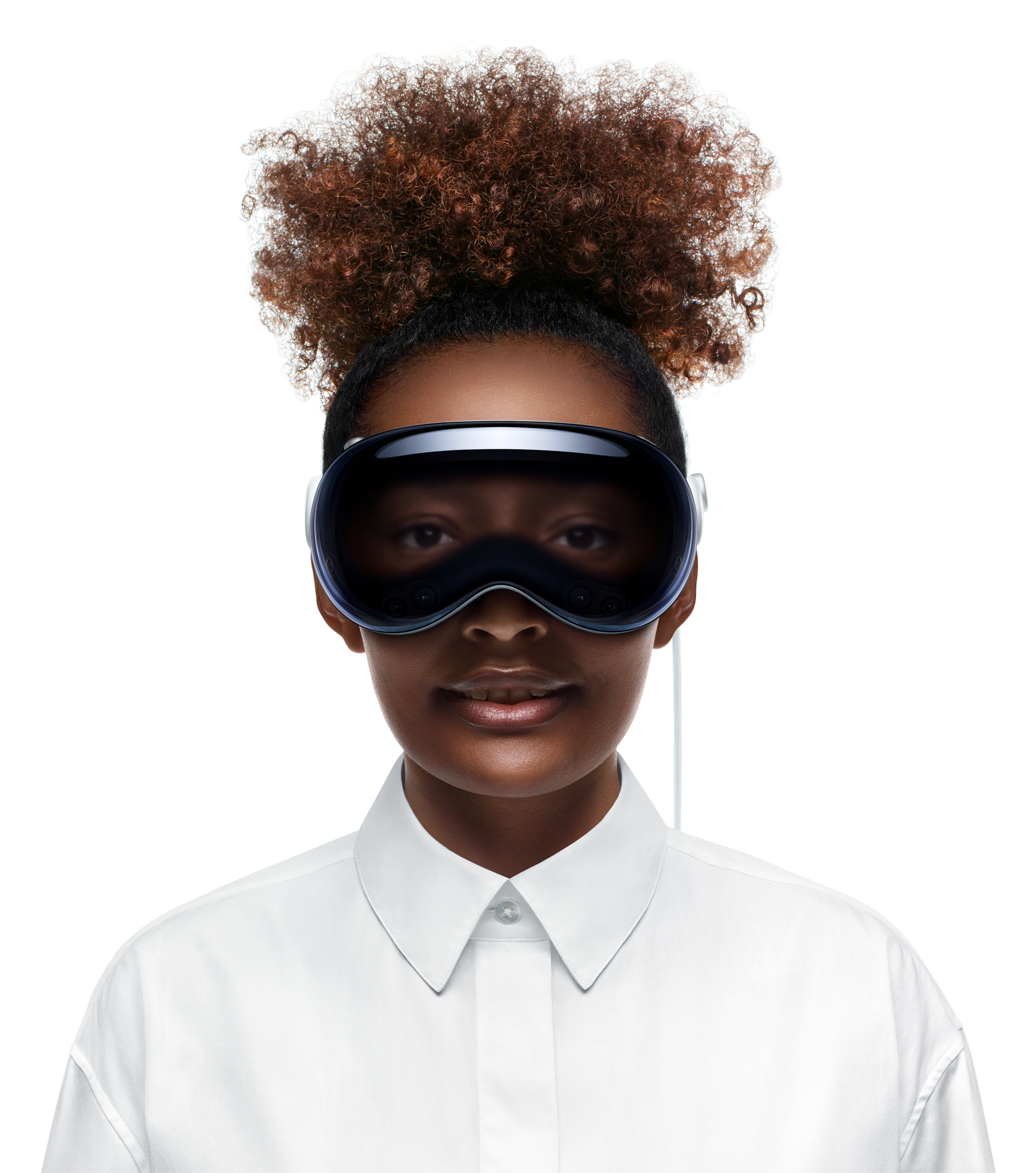
Behold, a new era of mixed reality is upon us. Or as Apple would prefer to call it, “spatial computing.” The tech giant has unveiled the Apple Vision Pro, its first major product since the Apple Watch in 2015, a headset that displays high-fidelity digital content in ways that blend with users’ physical spaces. It’s not unlike your Macbook interface or iPhone apps, except spatialized, right in your face. The release promises to transform productivity, connection, entertainment—and even creativity. How? Let’s break it down.
What is the Apple Vision Pro?
I found out at Apple’s top-secret New York demo space. Donning the futuristic Apple Vision Pro, I was first greeted by a three-dimensional user interface, dotted with app icons like those on any mobile computer, which appeared against my actual environment. The goggles also do away with the usual hand controls, using sensors to pick up my eye movements and hand gestures for inputs.
The Apple Vision Pro home screen, featuring apps against a partially immersive digital landscape. Photo courtesy of Apple.
By staring at buttons and using a variety of pinching and swiping gestures, I could browse a Safari window, scroll through photos, and stream movies on the Disney+ app while surrounded by a digital recreation of the desert planet Tatooine (of Star Wars fame), without losing the sense of where I was or the people beside me. Spatial videos, which can be captured by the headset or with the iPhone 15 Pro or Pro Max, were also impressive to view in three dimensions, with spatial audio, and in life-sized detail.
A spatial video viewed on the Apple Vision Pro. Photo courtesy of Apple.
In basic terms, this is Apple’s bid to rethink virtual reality without losing human connection. But if I wished to not connect with humans, there’s the option to go fully immersive. By turning a knob on top of the headset called the Digital Crown, I could fill my field of vision and background my apps with dynamic digital landscapes like a mountaintop or lakeside view, all in eye-wateringly high resolution.
Is it the metaverse?
It is not the metaverse.
What does any of it have to do with art or art-making?
Another thing Apple is emphasizing with the Apple Vision Pro is its offer of an “infinite canvas” (not unlike the way it put its iPad in the service of David Hockney). The company is referring to the platform’s functions as much as the boundary-less field of vision that creators could work with, whether using the spatial computer as a medium or tool. Delivering ultra high-def immersive content could potentially be a cinch, as could 3D presentations and collaborative work. One can imagine the possibilities for the producers of augmented reality or mixed reality installations, or for the Olafur Eliassons of the world, whose practices hinge on the experiential.
The JigSpace app on Apple Vision Pro. Photo courtesy of Apple.
There might be something here for museums and galleries, too. Currently, among the 600 apps that have been built for the platform are some that cleverly leverage its transportive potential. There’s Hold the World, which places users in London’s Natural History Museum for a tour of its rare specimens with David Attenborough; and The Archive, which immerses viewers in environments from deep sea to space. Even its mindfulness app capitalizes on the headset’s immersive potential, delivering a meditative experience that recalls that of an Infinity Mirrored Room.
Has anyone made art with the headset yet?
So far, the art made with the Apple Vision Pro has tended toward, well, performance art. Since the product’s launch, social media users have recorded videos of themselves strapped into the headset while hosting a dinner party, riding the subway, flying a plane, and driving a Tesla—their actual environs overlaid with various apps. One guy even cheekily reported how he could “watch a hundred different things at the same time,” his entire visual range crowded with sports videos, a sports betting website, and an X feed. All of it is either commentary on the most life-changing tech ever or the kind of dystopian age it’s ushering in.
It does give low-key Black Mirror vibes.
The EyeSight function on Apple Vision Pro, not a scene from Black Mirror. Photo courtesy of Apple.
Yes, there are some aspects about the Apple Vision Pro that might appear unsettling. For one, there’s the headset’s EyeSight Function, which displays a stereoscopic video projection of the user’s eyes on the front of the goggles. It’s Apple’s way of maintaining that much-touted human connection, allowing people who are interacting with the wearer to feel like they’re making eye contact. In a similar way, the spatial videos are intended to let viewers “relive” captured memories. But it’s unclear if the connection is all that human or true, the contact being this tech-mediated that one’s eyes are rendered in lenticular form and one’s memories play on a digital loop.
Or maybe this is all super cool and cutting-edge, and we’ve just consumed too much dystopian science fiction.
Okay, so what’s the catch with the headset?
Chiefly, the Apple Vision Pro’s price tag. The headset retails at $3,499, an investment far outstripping that of most V.R. headsets on the market and even a standard Macbook. It’s likely that the price will sink down as Apple inevitably releases more iterations of the technology. But for now, this costly, high-definition, immersive mixed reality experience largely remains a luxury reserved for a select few. The rest of us will have to make do with common, non-spatial computing. Alas.